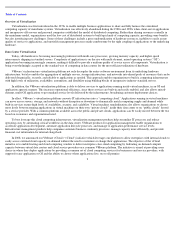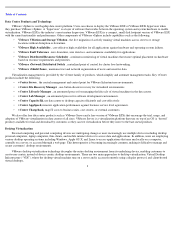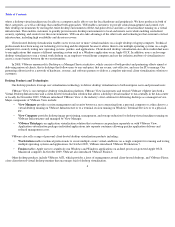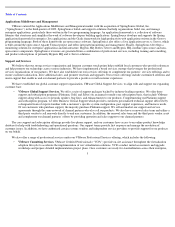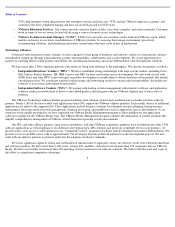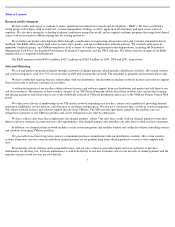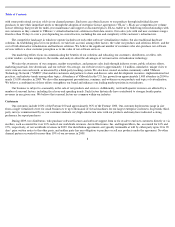VMware 2009 Annual Report Download - page 15
Download and view the complete annual report
Please find page 15 of the 2009 VMware annual report below. You can navigate through the pages in the report by either clicking on the pages listed below, or by using the keyword search tool below to find specific information within the annual report.
Table of Contents
compete with our virtual infrastructure and other virtualization product offerings. We also face competition from other companies and there have
been a number of announcements of new product initiatives, alliances and consolidation efforts by our competitors. For example, Citrix Systems
continues to enhance its server virtualization offerings and its virtual desktop offering and has also announced plans for a cloud computing
offering. During 2009, Oracle completed its acquisition of Virtual Iron and in early 2010 completed its acquisition of Sun Microsystems which
has its own hypervisor-based virtualization technology, Microsoft recently released the second version of its hypervisor-based server
virtualization product and IBM, Google and Amazon have announced new cloud computing initiatives. Other companies have also indicated
their intention to expand offerings of virtual management solutions.
We believe that the key competitive factors in the virtualization and cloud computing markets include:
Existing and future competitors may introduce products in the same markets we serve or intend to serve, and competing products may have
better performance, lower prices, better functionality and broader acceptance than our products. Our competitors may also add features to their
virtualization products similar to features that presently differentiate our product offerings from theirs. Many of our current or potential
competitors also have longer operating histories, greater name recognition, larger customer bases and significantly greater financial, technical,
sales, marketing and other resources than we do. This competition could result in increased pricing pressure and sales and marketing expenses,
thereby materially reducing our operating margins, and could harm our ability to increase, or cause us to lose, market share. Increased
competition also may prevent us from entering into or renewing service contracts on terms similar to those that we currently offer and may cause
the length of our sales cycle to increase. Some of our competitors and potential competitors supply a wide variety of products to, and have well-
established relationships with, our current and prospective end users. Some of these competitors have in the past and may in the future take
advantage of their existing relationships to engage in business practices that make our products less attractive to our end users. For example,
Microsoft has implemented distribution arrangements with x86 system vendors and ISVs, related to certain of their operating systems that only
permit the use of Microsoft’s virtualization format and do not allow the use of our corresponding format. Microsoft has in the past also
implemented pricing policies that require customers to pay additional license fees based on certain uses of virtualization technology and other
competitors have limited or denied support for their applications running in VMware virtualization environments. These distribution and
licensing restrictions, as well as other business practices that may be adopted in the future by our competitors, could materially impact our
prospects regardless of the merits of our products. In addition, competitors with existing relationships with our current or prospective end users
could in the future integrate competitive capabilities into their existing products and make them available without additional charge. For
example, Oracle provides free server virtualization software intended to support Oracle and non-
Oracle applications and Microsoft offers its own
server virtualization software packaged with the 2008 release of its Windows server product. By engaging in such business practices, our
competitors can diminish competitive advantages we may possess by incentivizing end users to choose products that lack some of the technical
advantages of our own offerings.
12
•
the level of reliability and new functionality of product offerings;
•
the ability to provide full virtual infrastructure solutions;
•
the ability to offer products that support multiple hardware platforms and operating systems;
•
the proven track record of formulating and delivering a roadmap of virtualization capabilities;
•
pricing of products, individually and in bundles;
•
the ability to attract and preserve a large installed base of customers;
•
the ability to create and maintain partnering opportunities with hardware and infrastructure software vendors and development of
robust indirect sales channels; and
•
the ability to attract and retain virtualization and systems experts as key employees.


